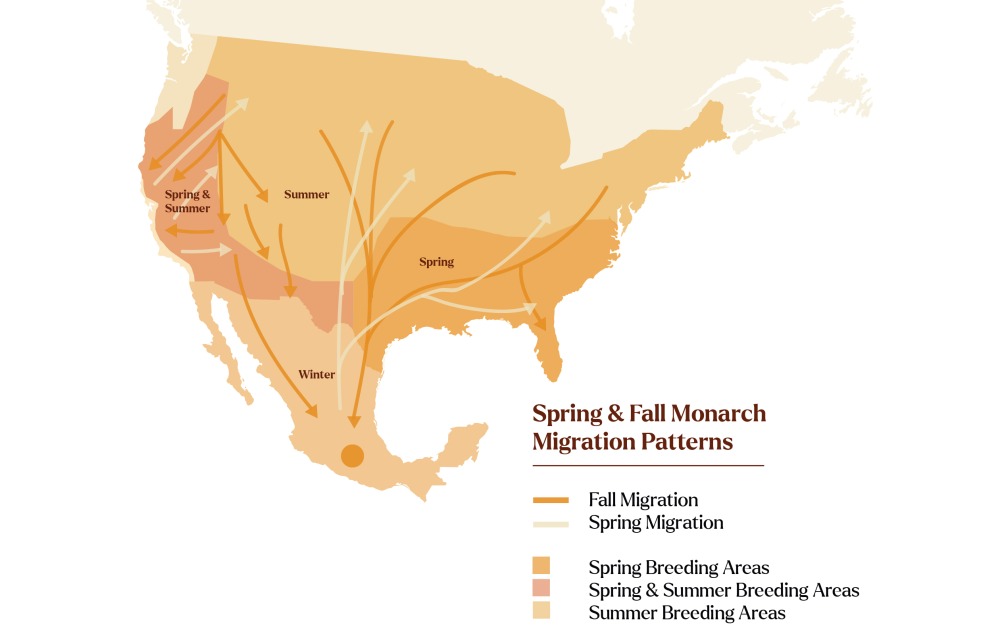Promising News for Monarch Butterflies!

The orange-and-black Monarch butterfly is extraordinarily beautiful, with white spots adorning the edges of its wings. Native to North America, the population is divided into western and eastern groups. Each fall, these butterflies travel nearly 3,000 miles from their summer breeding grounds in the northern United States and southern Canada to mountain forests in Central Mexico and southern California, where they forage and rest for the winter from November to mid-March. They are the only North American butterfly to undertake this astounding journey.

Monarch populations have been in decline since the 1990s, and they are currently facing extinction within the next 50 years due to their habitat being lost to development, agriculture, and logging. But in recent good news, the eastern Monarch population nearly doubled in 2025, according to a new survey conducted by WWF-Mexico and Mexico’s National Commission of Protected Natural Areas in collaboration with local communities. The population wintering in central Mexico’s forests occupied a larger area than the previous winter: 4.42 acres as compared to 2.22 acres. The improvement is linked to a decrease in forest degradation of 10% over 2023-2024 at the core of the Monarch Butterfly Biosphere Reserve in Mexico, a UNESCO World Heritage Site where the species overwinters.
 This promising progress in Monarch recovery underlines the urgency of protecting the Monarch’s precious habitat from illegal logging as well as sanctioned urban development and spreading agriculture.
This promising progress in Monarch recovery underlines the urgency of protecting the Monarch’s precious habitat from illegal logging as well as sanctioned urban development and spreading agriculture.
Monarchs only lay their eggs on milkweed plants, where their caterpillars and their young—emerging after the fascinating process of metamorphosis—feed only on milkweed leaves all summer. Adult Monarchs eat the nectar from a variety of flowering plants. They are important pollinators, helping ecosystems thrive across their range. They depend on healthy forests for protection in winter.

Endangered Monarch butterflies, by JHVEPhoto
The return trip south is completed by not one but three to five generations of Monarch butterflies, each fulfilling their role in keeping the species alive. Rainforest Trust and other dedicated conservationists are working to make sure they find the habitat they need when they arrive at their destinations, both north and south.
Human developments and agriculture have destroyed their habitat of open meadows, marshes, and prairies with abundant milkweed across their range, leading to a dangerous decline in their populations. Climate change is leading to more frequent and extended droughts, which limits milkweed growth and causes more frequent wildfires.
In August of 2022, Rainforest Trust and our partner, Pronatura Noreste, worked together to achieve the official designation of 1,372,671 acres of the Monarch Butterfly Migratory Corridor of the Sierra Madre Oriental Protected Area, protecting critical Monarch stop-over habitat in Mexico from encroaching agriculture and oil and gas extraction. The reserve is part of a larger strategy to ensure conservation and connectivity between protected areas in the region, including the neighboring 1,853-acre Regalo de Dios Voluntary Conservation Area, supported by Rainforest Trust and established in August 2019.
To bounce back, Monarchs need organizations like Rainforest Trust along with our partners, governments, landowners, conservationists—and supporters like you—to permanently safeguard intact landscapes along the Monarch’s migratory route. To save the Monarchs, logging for any purpose, destruction of essential meadowlands, and the use of herbicides and insecticides must be stopped where Monarchs feed, overwinter, and breed. Together, we can save the iconic Monarch butterfly!








